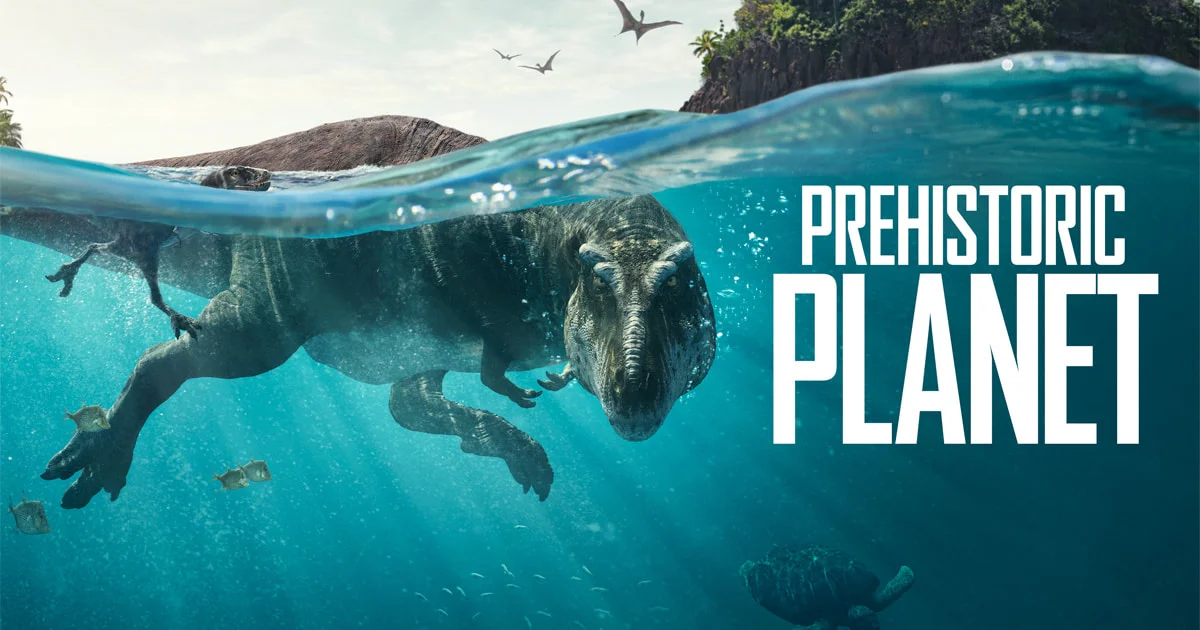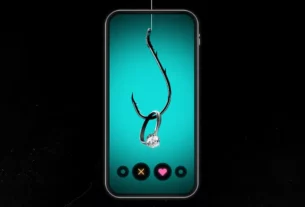IMDB 8.9! The BBC makes the best dinosaur documentary in two decades!
IMDB 8.9, such a result, can be fully included in the discussion of “God’s work”. And this is the answer given by the BBC’s latest dinosaur documentary “Prehistoric Planet”, which is released on Apple TV in a daily episode from Monday to Friday.
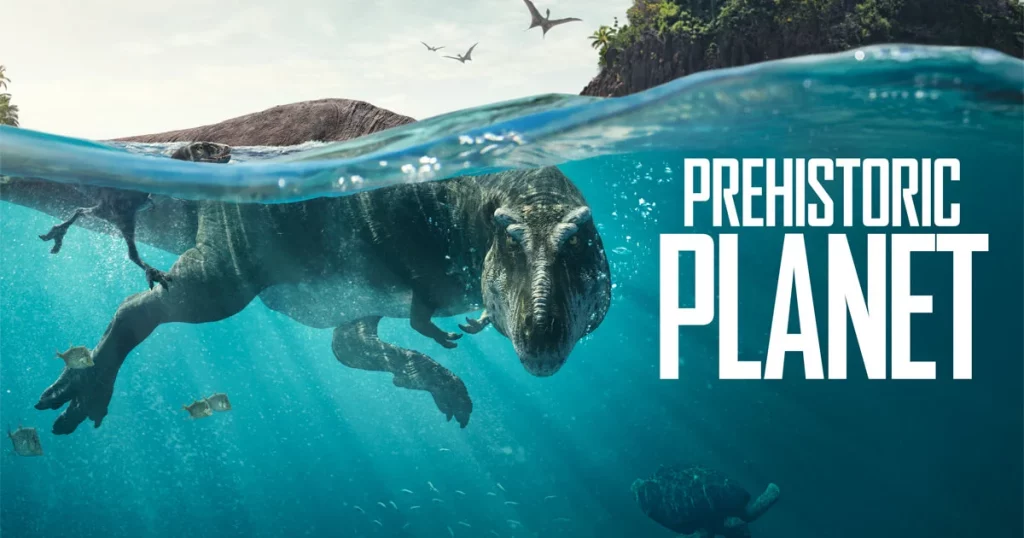
Comparable to it is probably only the predecessor “Walking with Dinosaurs” (IMDB 8.5), who was born in the same family more than 20 years ago.
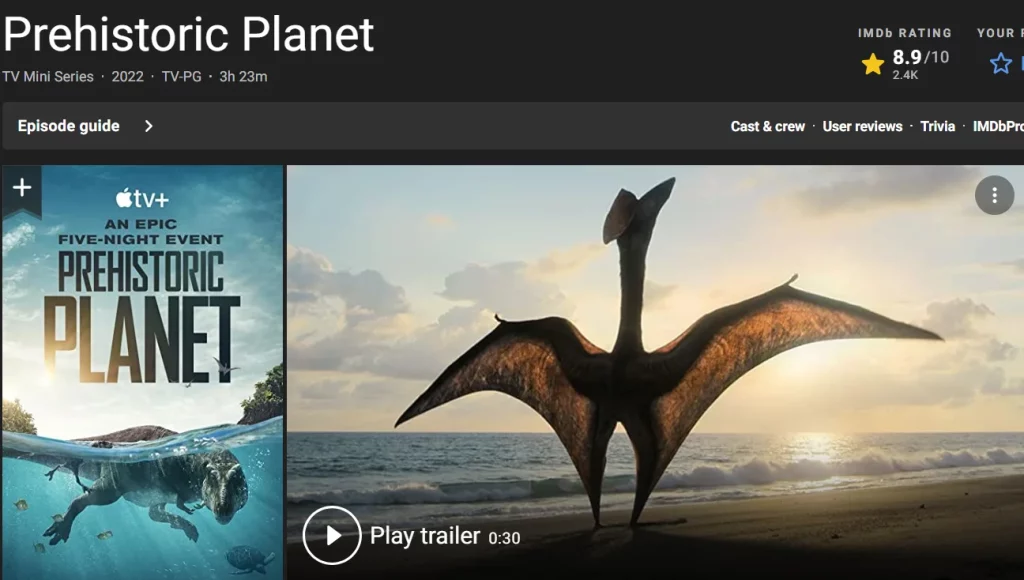
As the BBC’s new documentary, “Prehistoric Planet” lives up to its expectations, inheriting the glorious mantle of its predecessors “Walking with Dinosaurs”, “Walking with Monsters”, “Walking with Monsters”), while making full use of today’s The most advanced production technology, with burning funds, in each episode, presents the audience with a vivid Cretaceous Earth in different environments.
BBC Classic Paleontology Documentary – “Prehistoric Creatures Trilogy” series.

Of course, to have such a reputation, it is definitely impossible to rely on “appearance” alone. In “Prehistoric Planet”, there are many paleontological research results that have never been presented in documentaries before.
These contents, not to mention for ordinary audiences, are also quite interesting for ordinary paleontology lovers.
It is precisely because of its beautiful pictures and rich paleontological knowledge that “Prehistoric Planet” has become a brand new monument in the history of paleontological documentaries.
Some viewers even said in a joking tone: “I was at the scene, and this was all taken by traveling back and holding a camera.”
Although it is a joke, it also reflects the recognition of the quality of the series to a certain extent.
Having said so much, let’s walk into the Cretaceous Earth more than 60 million years ago and experience a prehistoric journey full of shock and surprise.
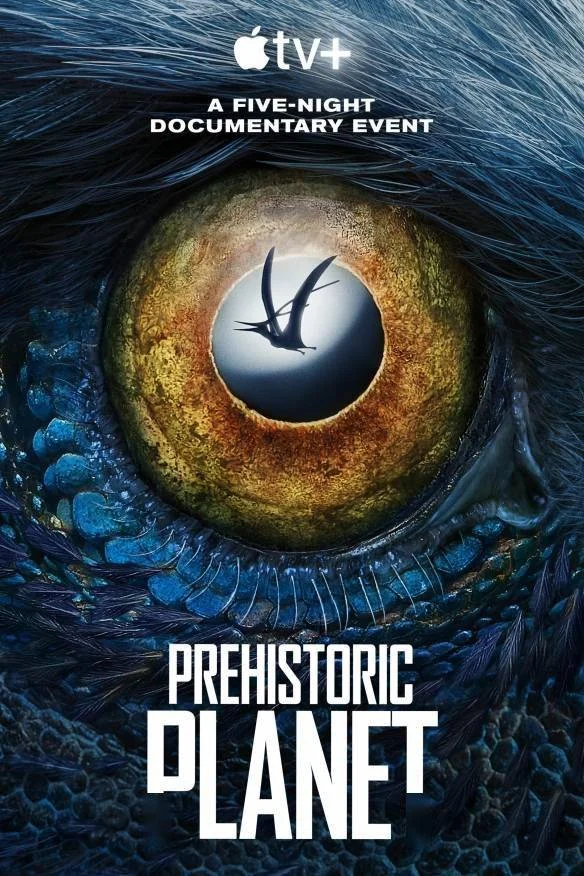
At the beginning of the first episode, Tyrannosaurus, the undisputed No.1 superstar in the dinosaur family, met the audience. It seems that the director is well aware of the truth that “a good start is half the battle”.
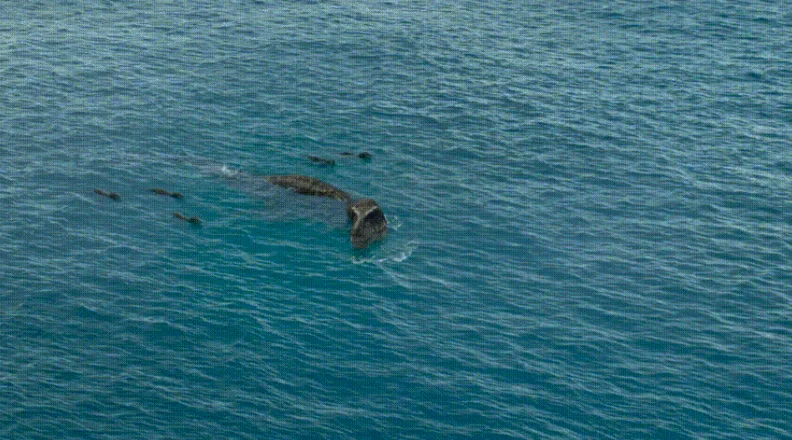
However, it did not debut in the way of killing the Quartet on land in our first impression, but first showed everyone his not-so-well-known “swimmer” side.
However, the jury is still out on how well Tyrannosaurus can move in water.
Although it does have favorable conditions such as “hollow and air-filled bones” and “strong hindlimbs” as stated in the film, at the same time, adult Tyrannosaurus has a body length of 11-14 meters, an average weight of about 9 tons and an average weight of about 9 tons. The most stout body in the theropod family also provides enough evidence for people who are not optimistic about the “watery” Tyrannosaurus.
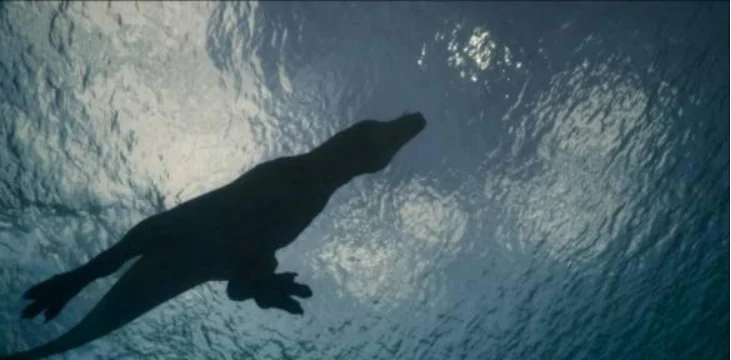
As for this debate, I personally prefer that its water quality is not good. As for the reason, look at the comparison between Tyrannosaurus and Spinosaurus, the largest highly aquatic dinosaur that has been confirmed so far. Easy to understand.
Although the newly restored Spinosaurus will only be crushed if it is dry on land, if it is in the water, the “underwater hardware” of Tyrannosaurus is obviously more than one grade worse.
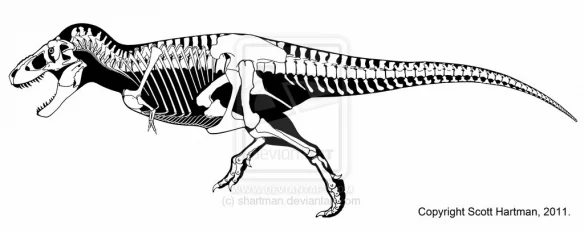
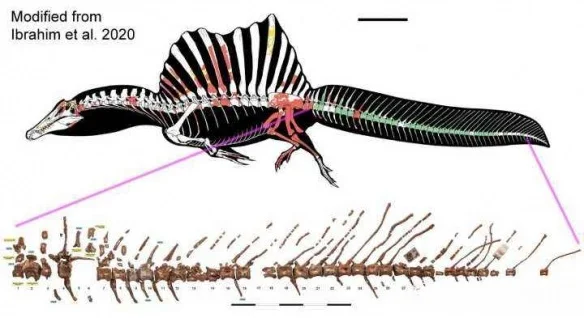
The skeleton restoration diagrams of Tyrannosaurus (top) and Spinosaurus (bottom), not to mention the body lines and limb structure, the spinosaurus, an oversized eel tail alone, Tyrannosaurus can only be far behind.
But while different people will have different opinions, no matter which side you’re on, the near-perfect audio-visual feast that “Prehistoric Planet” offers right from the start of the series is breathtaking.
Looking at the modeling and effects, if I didn’t know that the dinosaurs were extinct, I’m afraid I would also think that this is a real shot.

Since it comes to modeling, Tyrannosaurus in this work also has some points worth mentioning in modeling. The first is the very obvious difference in hair between adults and juveniles.
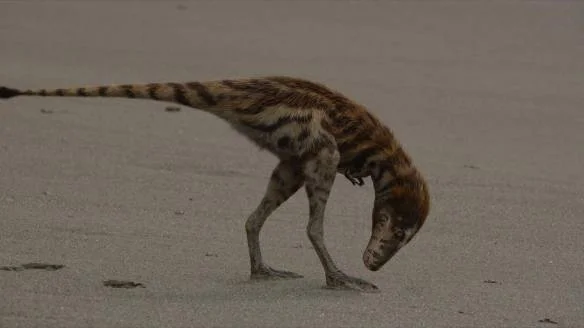
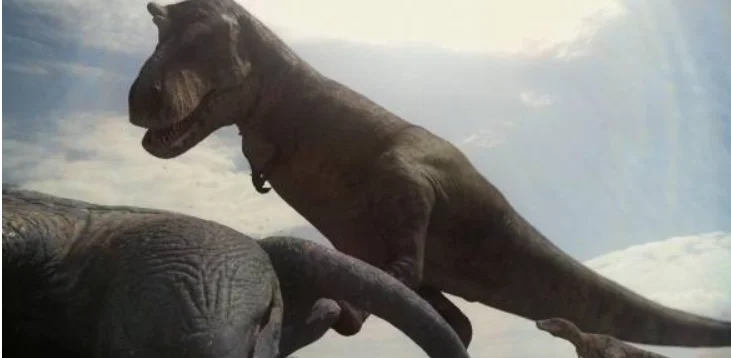
From cub (top) to adult (bottom), Tyrannosaurus perfectly shows us “I’m getting bald and stronger”
This difference is actually a demonstration of previous research on Tyrannosaurus, and even the entire Tyrannosaurus hair.
After fossil evidence such as Rex orchid pointed directly to the discovery of large feathered theropods, many of its congeners have undergone a restoration image evolution from “bare tuatara → hairy giant free-range bird”.
During this period, some people even restored Tyrannosaurus to this:
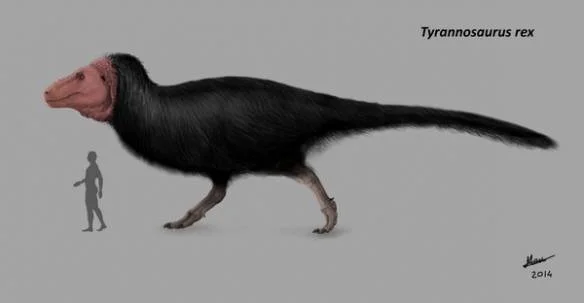
But obviously, although this type of restoration did fit the trend of “hairy dinosaurs” at that time, it was neither in line with the fossil evidence nor with the characteristics of the habitat.
In all the adult fossils of large tyrannosaurs, no traces of feather tissue have been found, but there are many real hammers with scale structures.
Combined with global warming trends at the time and the latitude of Tyrannosaurus’ common habitat, behemoths like Tyrannosaurus had a smaller body-surface-area ratio, according to the “law of Haldane.”
That is to say, they can better retain body heat. Under this premise, if the Tyrannosaurus put on a “sweater” again, they would probably heat themselves to death when they hunted.
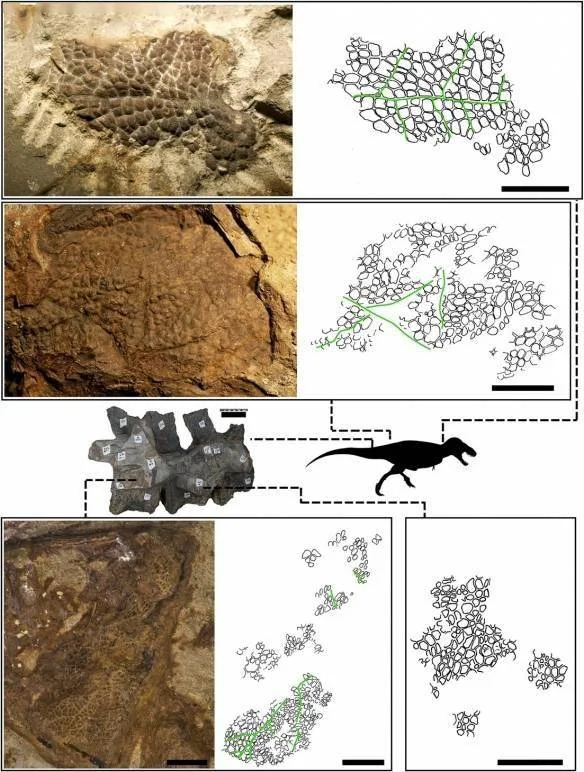
In the fossil record of large tyrannosaurs, there are no traces of feathers, but there are some real hammers with scale structures
Therefore, the more mainstream Tyrannosaurus restoration has returned to the appearance of most of the body surface being bare. Even if there is hair, it will only be distributed in sporadic places, just like in “Prehistoric Planet”.
Seeing this, you may ask, “What’s with the fancy fur on that cub?”
The answer to this question actually comes from a distant relative of Tyrannosaurus, Sciurumimus, found in Germany that lived in the late Jurassic.
The holotype was derived from a juvenile with a fossil integrity of 98%. From the fossil traces, the body of this Sciurumimus larva must be covered with feathers.
It is also this discovery that made the idea that large theropods shed their feathers in their infancy and shed their feathers in adulthood, and began to be accepted by many people.
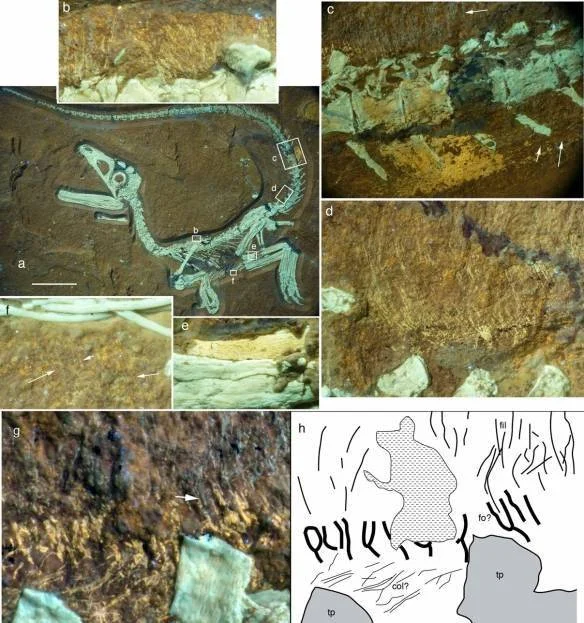
Traces of feather structure are clearly visible in this highly intact fossil of Sciurumimus larvae
In addition to the difference in hair between the pup and the adult, another point worth mentioning in the modeling of Tyrannosaurus in this work is its lips.
Take the modeling in the BBC’s own “Walking with Dinosaurs” for comparison:
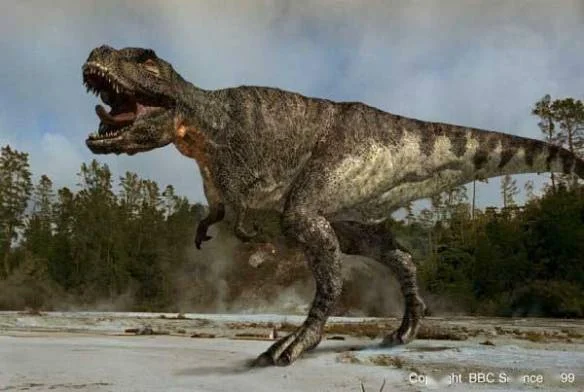
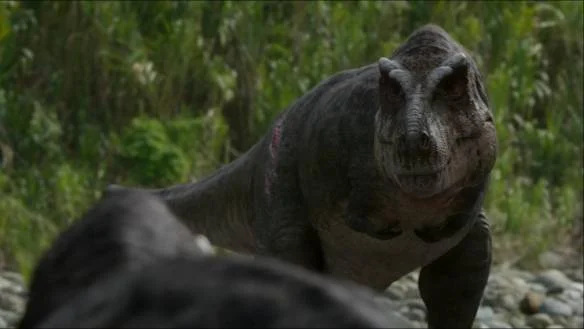
Tyrannosaurus in “Walking with Dinosaurs” (top) and “Prehistoric Planet” (bottom), the difference in the lips can be clearly seen
It can be seen that compared to the grinning and fierce look in “Walking with Dinosaurs”, Tyrannosaurus in “Prehistoric Planet” looks obviously softer.
Even from certain angles, it looks a bit simple and honest. And such a difference is actually a kind of “standing line” for the restoration of Tyrannosaurus’ image.
After all, so far, it is still inconclusive as to whether Tyrannosaurus has lips or not.
The basis for the view of “has lips” is the degree of development of the trophic hole in the snout on the skull.
Here it is necessary to first introduce the nourishing hole – the so-called nourishing hole, which is the small hole in the bone for the nourishing blood vessel to pass through. Generally speaking, the more and larger the trophoblast, the more developed the soft tissue attached to the bone.
The trophoblasts of the fossil snout of Tyrannosaurus skulls are similar in development to their modern relatives, the komodo dragon, and far higher than that of another group of relatives, the crocodiles.

Tyrannosaurus (left), komodo dragon (middle), and crocodile (right) skull comparisons, clearly showing differences in the level of trophoblast development
That is to say, based on this, Tyrannosaurus will definitely not have the appearance of a crocodile with all its big teeth bared outside, but should be closer to having thick lips like a monitor lizard.
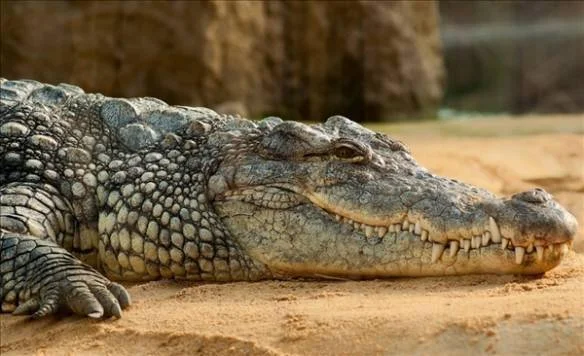
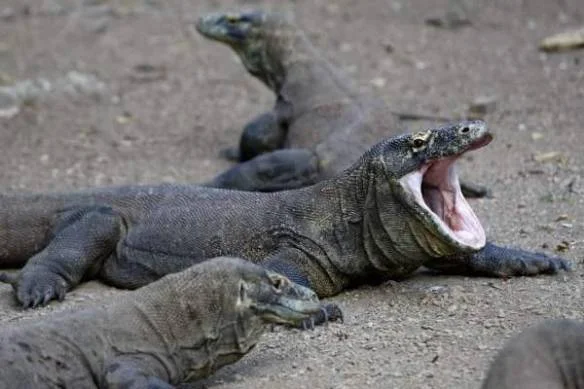
Based on the nourishment hole, compared to the crocodile (top), Tyrannosaurus must have the same lips as the monitor lizard (bottom). As for whether it is so thick, it is hard to say.
For those who hold the “lipless” view, their main basis is fossil evidence.
Although Tyrannosaurus has not found complete skin fossils so far, D. horneri, a relative of Tyrannosaurus from the Late Cretaceous Northern America, has relatively complete skin fossils unearthed.
In the skull parts of these fossils, no traces of soft tissue like lips were found, but some scale marks similar to crocodiles were found.
This seems to suggest that the snout of D. horneri is like that of a crocodile, with the teeth directly exposed. As a close relative of Tyrannosaurus, which belongs to the same genus of Tyrannosaurus, this discovery is likely to have certain reference value.
Fossilized skull of D. horneri and its reconstructed head
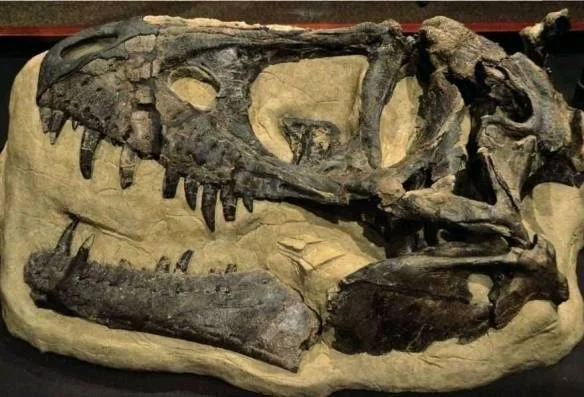
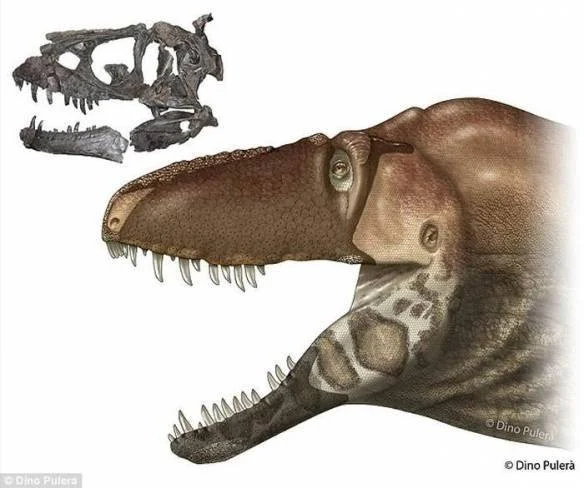
So far, the two factions are still fighting each other, but judging from the image of Tyrannosaurus in “Prehistoric Planet”, at least the BBC is definitely in the “lip” faction.
After talking about the land overlord, let’s talk about the water devil. Since the 40-meter Mosasaurus was built in “Jurassic Park”, Mosasaurus has gradually become a ceiling-like existence for aquatic animals.
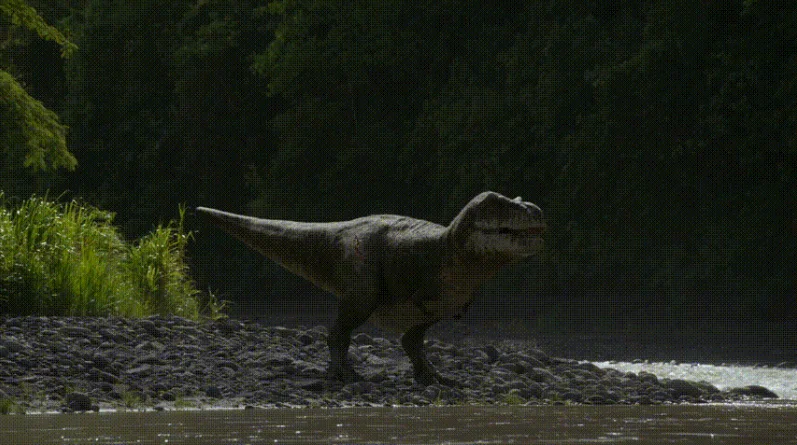
Of course, this kind of development is somewhat of a popularity bonus. After all, although Mosasaurus is indeed superior in combat power, it is still a notch lower than that of the famous old enemies of the Miocene – Megalodon and Livyatan melvillei.
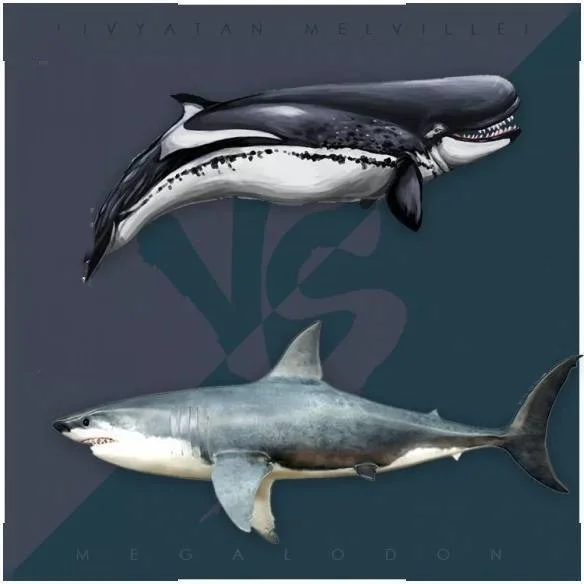
As the top predators of the era, Mosasaurus is still a grade worse than the old enemies of Megalodon and Livyatan melvillei
But yard by yard, no matter how fierce Megalodon and Livyatan melvillei are, it is impossible to cross into the Cretaceous sea to face Mosasaurus. Therefore, in the world of “Prehistoric Planet”, Mosasaurus is undoubtedly a well-deserved ocean overlord.
These 15 meters long, 15 tons of marine reptiles can be said to firmly occupy the highest ecological niche in the ocean at that time.
This is thanks to the top hardware that comes with their strong heads with sharp, conical teeth and scaly, long, hydrodynamic barrel shapes.
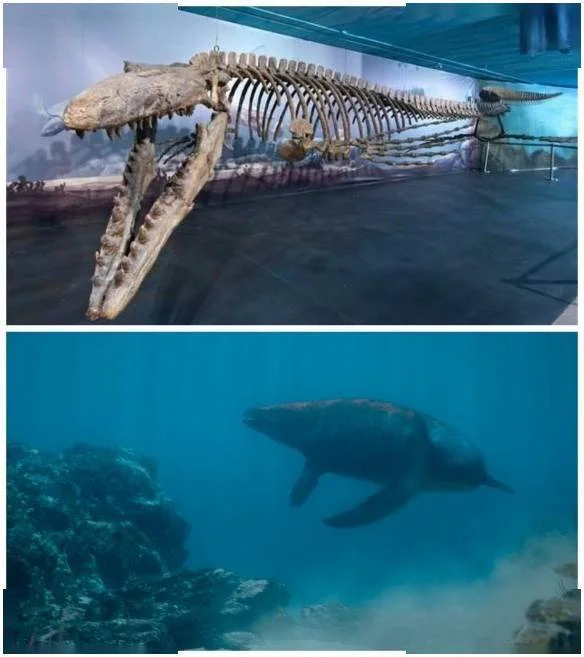
Mosasaurus Fossil and Mosasaurus Image from “Prehistoric Planet”
For such top predators, all kinds of intense and bloody “not suitable for children” scenes are naturally trivial, but in this work, the director and production team ingeniously showed us the “warm” side of these prehistoric giants .
In the blue sea, a small fish was swimming freely. At this time, a huge black shadow slowly approached – it was a huge Mosasaurus hoffmanni. It came behind the little fish and opened its bloody mouth…
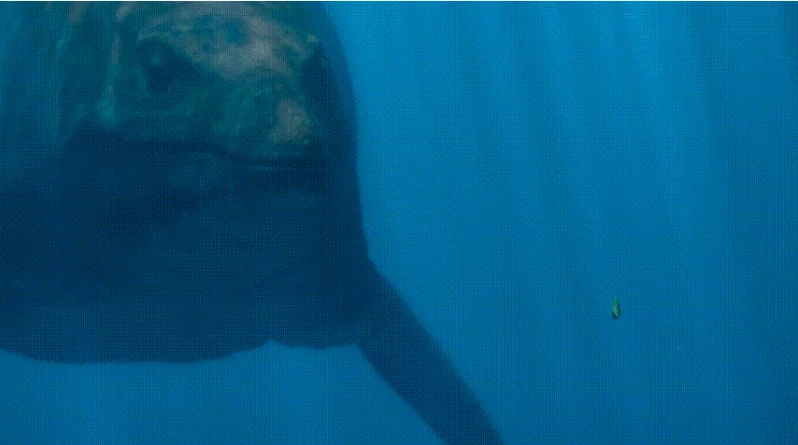
According to the normal development of the plot, this poor little fish must be doomed, but unexpectedly, it did not become Mosasaurus’ meal, but filled his stomach from Mosasaurus.
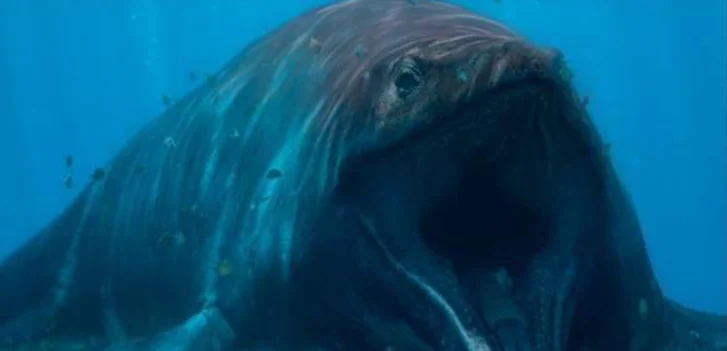
That’s right, the food scraps in Mosasaurus’ mouth and the skin scales that fell off his body are definitely a big meal for these small fish and shrimp.
After a set of operations, Mosasaurus enjoyed the service like a bath center, and the small fish and shrimp were also full of food.
Such warm, harmonious and mutually beneficial scenes still exist in today’s ocean. In other words, this bridge in “Prehistoric Planet” is derived from Labroides dimidiatus and Neon Blue Goby, which are now commonly known as “clean fish”.
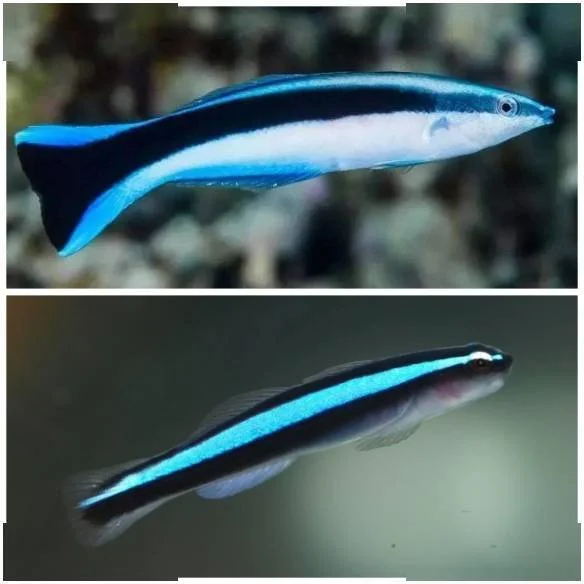
Labroides dimidiatus (top) and Neon Blue Goby (bottom)
The role of these two seemingly inconspicuous small fish in the marine world cannot be ignored. In addition to the “clean” in their common name, they can also provide protection for those “big fish” troubled by microorganisms and parasites. They heal sickness.
If it is placed in human society, how can it be regarded as a famous doctor?
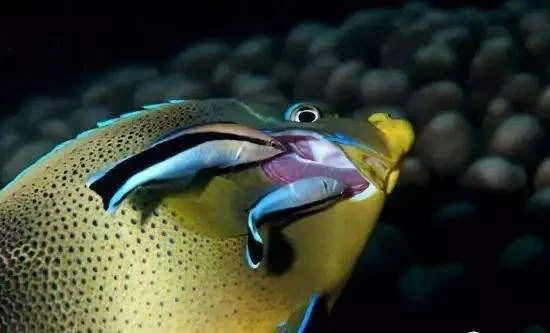
Labroides dimidiatus in “Healing”
Based on this, this “Mosasaurus’ tender time” in “Prehistoric Planet” is quite exquisite.
From a biological point of view, the role of large predators in the entire ecology is indeed both “consumers” and “suppliers”.
From the point of view of the documentary, such a “tender tenderness”-like contrast also adds a lot to the look and feel of the entire drama.
Unlike most other documentaries based on fact, a large part of the content of paleontological documentaries is often the expression of the producer’s own point of view.
For example, the two unforgettable airbags on the neck of Dreadnoughtus in this work:
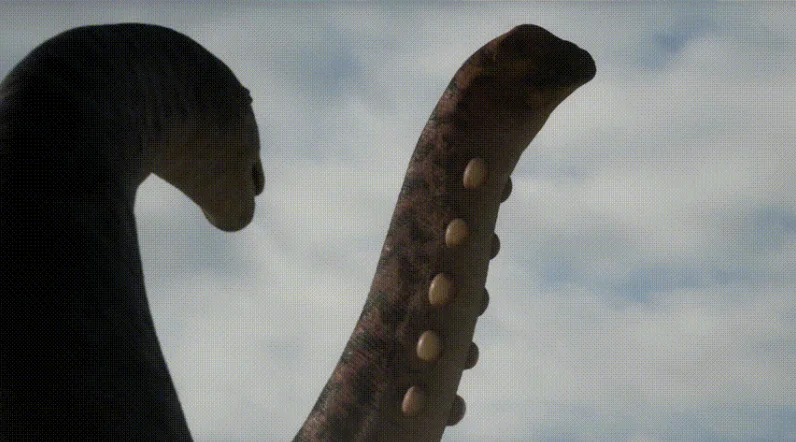
In fact, there is no real hammer basis for this image restoration, and the main function of this structure given in the film – to display courtship, can almost be said to be a “universal type” of various bells and whistles restoration features. by the head.
However, this is also the advantage of paleontological documentaries-for many ambiguous, unprovable and unfalsifiable parts, the production team can open their minds.
As long as it is novel and interesting enough, even if these ideas are proven wrong in the future, they can usually be tolerated enough.
In addition to the airbag version of Dreadnoughtus above, Barbaridactylus, who has “antlers” and “dresses as a woman”, is also a perfect embodiment of the “Prehistoric Planet” brain hole.
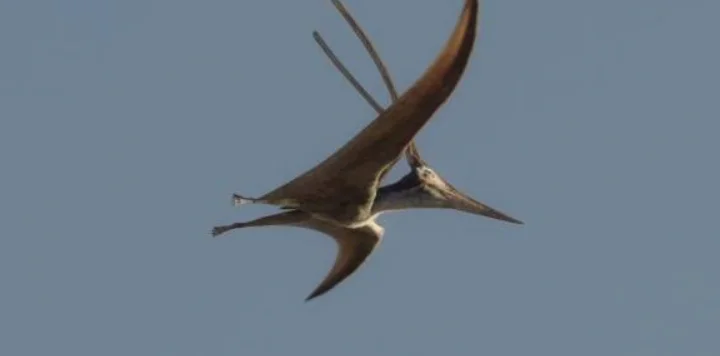
The production team first stood in line decisively, choosing the latter between the images of “crown with skin” and “antlers without skin”, and then added a line of “very few males without a crown will disguise as females, so as to to allow himself to live and court in the territory of other males”.
In the actual film, Barbaridactylus, who did so disguised as a female, was actually spotted by the male boss, almost putting on a philosophical drama.
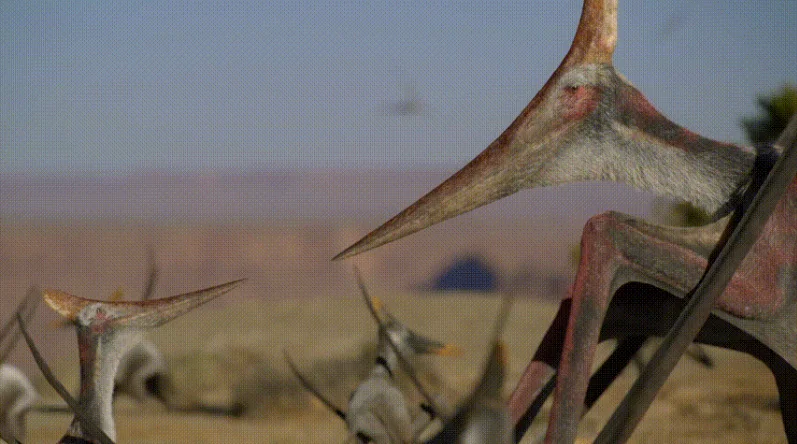
And this kind of drama actually comes from a kind of bird that actually exists in the animal world today – Philomachus pugnax.
This kind of bird with obvious differences in appearance between males and females, when it comes to the breeding season, the male birds will grow quite attractive and conspicuous feathers on their necks, like the following –
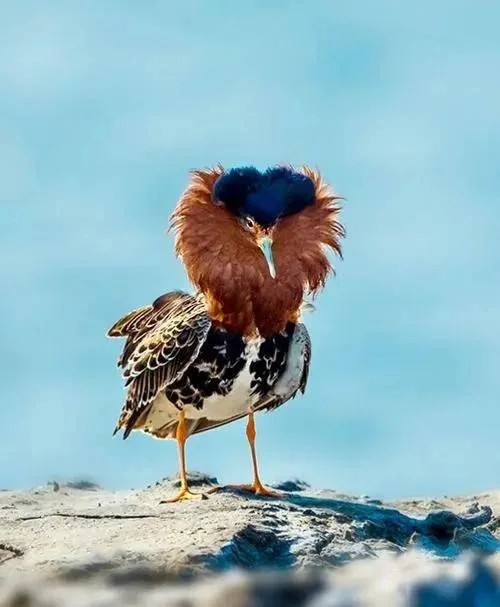
Most of them will also compete for territory and mating rights by showing off their feathers and fighting with force during this period.
And a small number of male Philomachus pugnax, who are not physically strong, are very self-aware of their own strength and know that there is no future in competing with those able-bodied compatriots, so they act as “guerrillas”, in several mating territories Between “running and committing crimes”, to pick up the leaks of the lords.
In the face of the “dazzling” female birds in the territory, the lords naturally paid attention to one thing and another, and turned one eye away.
In addition to them, there is an extremely rare group of male Philomachus pugnax (about 1% of the male population), and their appearance is indistinguishable from the female bird.
And with this “talent”, they can swagger in the mating territory and wait for the opportunity to mate with the females in the territory.
Of course, such “advantage” is not without cost. When Philomachus pugnax is seen by other male birds, they can’t be like the Barbaridactylus disguised as a female in “Prehistoric Planet” every time. base’s fate.
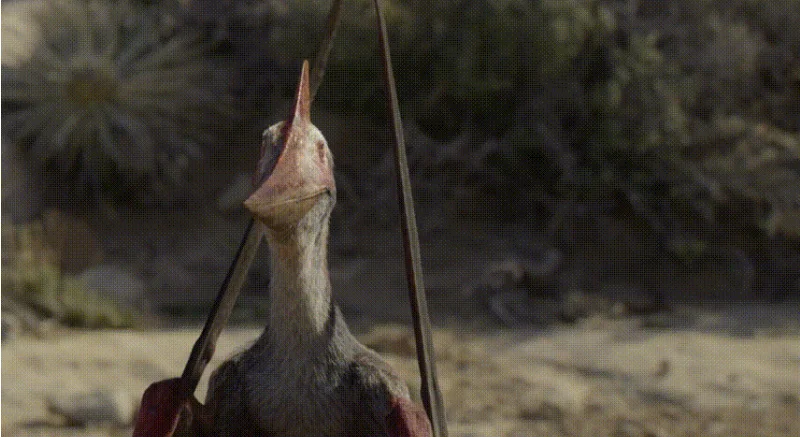
Such good luck does not come every time.
In fact, as stated in the trailer, “Prehistoric Planet” focuses more on the “unknown, unexplainable, and incredible” parts.
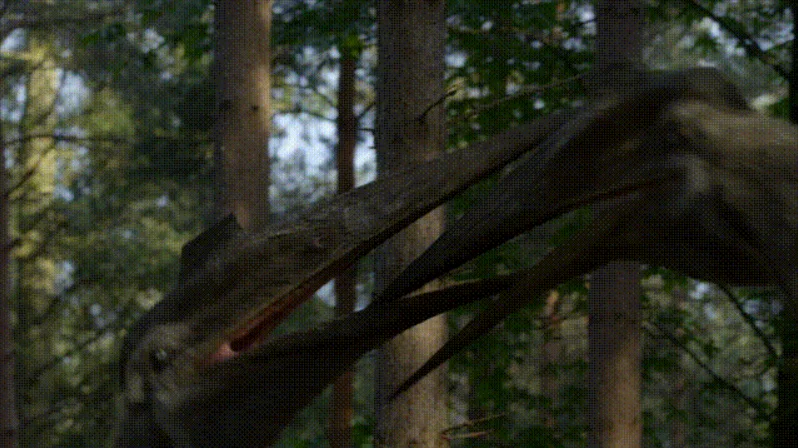
In addition to the above-mentioned content, there is also the land battle of Quetzalcoatlus, the largest known flying animal known as the “King of the Sky”:
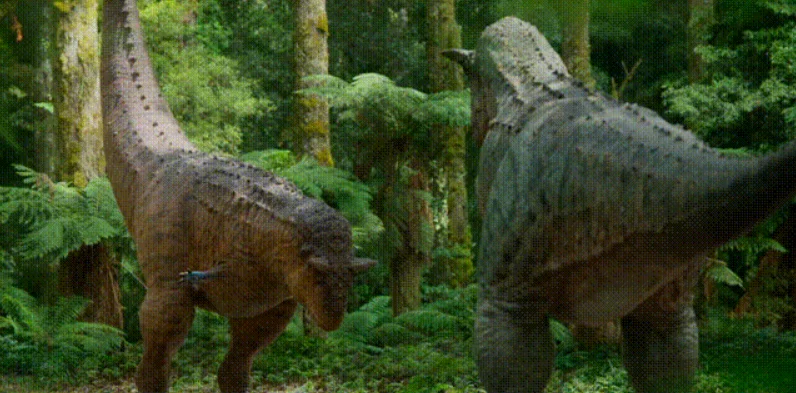
Waving his cute little short hands desperately, he was still a carnotaurus who had “nothing” in the end:
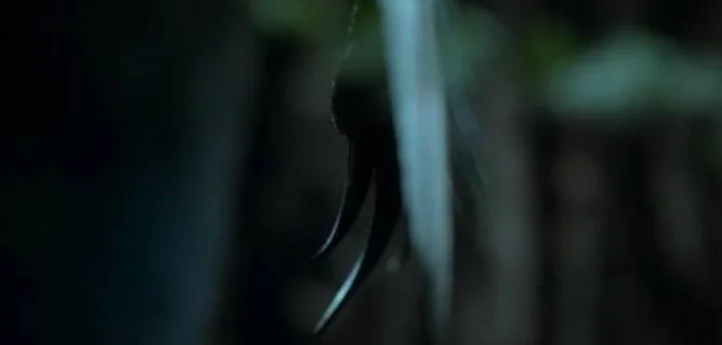
And Therizinosaurus, who likes to eat honey,by the way, in this work, the role of Therizinosaurus’ huge claws is also supported by many research results, from “self-defense weapons” to “eating tools”:
Such a choice is undoubtedly very wise in my opinion, and the word-of-mouth received after the launch of “Prehistoric Planet” also supports this.
After all, who could resist the quirky dinosaurs in the legendary Cretaceous world?
Related Post: The ancient creature masterpiece “Prehistoric Planet” is now officially finished, IMDB 9.0 points.
